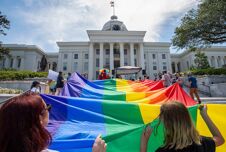Following each high-visible episode of gun violence in the United States, politicians and other community and national leaders spout their often-repeated, worn-out platitudes and false claims regarding the actual causes of this lethal epidemic plaguing the country. Their words all-to-often result in the silencing of the root causes of the problem.
“Sending my best wishes and prayers.”
Of course, people of goodwill and compassion express this sentiment to people and communities suffering trauma and grief. This can help to begin the often-long healing process at a time of unfathomable tragedy by providing essential solace to survivors. It also gives those of us who feel powerlessness during these occasions at least a limited sense of standing with others. This expression, though, falls far short of a solution, which morphs into mere platitude when those in positions of power fail to work toward real solutions.
“This is not the time to talk about politics.”
Never Miss a Beat
Subscribe to our newsletter to stay ahead of the latest LGBTQ+ political news and insights.
After virtually every firearms-related slaughter, a common pattern has emerged: when advocates rightly raise issues of safety regulations, politicians retreat to their deflective tactic of reciting that “now is not the time.” Moments pass leading to the next political issue (for example, healthcare or storm disaster relief) pushing gun violence out of the headlines as action is not taken, then the next high-visibility gun massacre blares out, politicians again claim “now is not the time,” and the cycle repeats ad infinitum.
“It’s about better securing our schools.”
When politicians make proposals for reducing gun violence, especially in our schools, they suggest such methods as installing metal detectors, self-locking building entrances, constant and updated emergency drills for the entire school population, and training for staff, teachers, and administrators. Increasingly, policy makers advocate for adding to the number of armed security monitors, and even arming teachers and administrators as “first-line” defenders.
This latter tactic follows National Rifle Association Executive VP Wayne LaPierre’s argument that “The only thing that stops a bad guy with a gun is a good guy with a gun.” In fact, the NRA produces stickers and hats inscribed with the motto: “Guns Save Lives.” But is this true? Several studies show the opposite.
The lead researcher, Charles Branas, in a University of Pennsylvania study concluded that by arming people as a defensive measure:
There was an expectation that we should surely find a protective value. [But having a gun] on average was found not to be protective in assaults…. Although successful defensive gun uses can and do occur, the findings of this study do not support the perception that such successes are likely.
In another research study, Harvard School of Public Health’s, David Hemenway, found that contrary to many claims, the chances of violence increased in homes with a gun. Branas, in his study, concurred:
[T]here is no credible evidence of a deterrent effect of firearms or that a gun in the home reduces the likelihood or severity of injury during an altercation or break-in.
What proponents of this simplistic and disastrous gun-on-gun philosophy fail to realize in their obsession (yes obsession) with the so-called “freedom” to bear arms is that it is not only “criminals who kill people.” Having augmented numbers of armed school personnel increases the risk for accidental injury and death while offering no guarantees of stopping acts of violence. Fighting fire with fire results in hotter and quicker-moving blazes.
“Guns don’t kill people. People kill people.”
Actually, people with guns kill people more often and at significantly higher rates than people who don’t have guns. Let’s take a comparative example.
Before and up to 1996, Australia had relatively high rates of murder, but an incident at Port Arthur, Tasmania, April 28, 1996, was the proverbial straw that broke the poor camel’s back. On that date, a man opened fire on a group of tourists killing 35 and wounding another 23. The massacre was the worst mass murder in Australia’s history.
Taking decisive action, newly-elected conservative Prime Minister, John Howard, negotiated a bipartisan deal between the national, state, and local governments in enacting comprehensive gun safety measures, which included a massive buyback of more than 600,000 semi-automatic rifles and shotguns, and laws prohibiting private firearms sales, mandatory registration by owners of all weapons, and the requirement that all potential buyers of guns at the time of purchase give a “genuine reason” other than general or overarching self-defense without documentation of necessity.
By 1996, polls showed overwhelming public support of approximately 90% for the new measures. And though firearms-related injuries and death have not totally come to an end, according to the Washington Post, homicides by firearms fell by 59% between 1995 and 2006 with no corresponding increase in non-firearm-related homicides, and a 65% reduction in gun-related suicides.
Other studies found significant drops in robberies involving firearms, and contrary to fears by some, no increase in the overall number of home invasions. In the decade preceding the Port Arthur massacre, Australia recorded 11 mass shootings. No mass shooting have occurred since the measures went into effect.
“It’s a mental health issue.”
When politicians assert a cause of gun violence, they invariably lay blame on people with mental illness. For example, NRA’s Wayne LaPierre accused “delusional killers” for the violence, and he called for a “national registry” of all persons diagnosed with mental illness. While this is certainly the case in some specific instances, the clear majority of people with this diagnosis do not manifest violence, and specifically, they are not the primary perpetrators of firearms-related injury and death to others.
Politicians are merely scapegoating an entire group of people rather than acknowledging the real causes. And while these same politicians call for increased support systems for people with mental health issues, this Republican-dominated Congress has acted to reduce supports.
On the issue of keeping guns out of the hands of people with emotional and mental health problems, in December 2016, the Obama administration released policy guidelines mandating that people receiving Social Security payments for severe mental illnesses and those found incapable of managing their finances undergo FBI’s National Instant Criminal Background Checks if they request to purchase a weapon.
Congress, however, overturned the policy, mostly on party lines. President Trump signed the measure into law one month after taking office even though following every mass shooting, he refers to these instances as a “mental health problem” as he did again after 17 students and their teachers were recently killed in Parkland, Florida.
In fact, however, reports show clearly that mass shootings by people with serious mental illness represent less than 1% of all yearly gun-related homicides. In addition, Columbia University’s Paul Applebaum and Duke’s Jeffrey Swanson found that “only 3-5% of violent acts are attributable to serious mental illness, and most do not involve guns.”
Hypermasculinity Combined with Widescale Availability of Firearms
In the over 50,000 shooting incidents in the United States in 2015, including approximately 372 categorized as “mass shootings” of four or more victims, men, mostly white men, committed the overwhelming majority. And murder is primarily a male act in 90% of the cases when the gender of the perpetrator is known. In mass shootings, 98%+ are enacted my males.
But regulations on firearms challenge the promises of a patriarchal system based on notions of hyper-masculinity with the elements taken to the extreme of control, domination over others and the environment, competitiveness, autonomy, rugged individualism, strength, toughness, forcefulness, and decisiveness, and, of course, never having to ask for help or assistance. Concepts of cooperation and community responsibility are pushed to the sidelines or often discarded. This connected to the easy legal access to firearms presents a recipe for disaster playing itself out so many times in the United States that is has become routine.
Why do politicians and many residents of the U.S. continue to deny, deflect, diffuse, dispose, and dispense with raising issues revolving around the massive and virtually unrestricted availability of firearms, some reaching military-grade capability, as the prime reason for the epidemic of gun violence in the United States? While the answer is detailed, I present a quick and appropriate glance at the problem:
National Rifle Association Campaign Donations
John McCain (R, AZ) – $7.74 million
Richard Burr (R, NC) – $6.99 million
Roy Blunt (R, MO) – $4.55 million
Thom Tillis (R, NC) – $4.42 million
Cory Gardner (R, CO) – $3.88 million
Marco Rubio (R, FL) — $3.30 million
Joni Ernst (R, IA) — 3,124,273
Rob Portman (R, OH) — $3,061,941
Todd Young (R, IN) — $2.9 million
Bill Cassidy (R, lA) — $2.86 million
French Hill (R, AR) – $1.09 million
Ken Buck (R, CO) – $800,544
David Young (R, IA) – $707,662
Mike Simpson, (R, ID) – $385,731
Greg Gianforte (R, MT) – $344,630
Donald Trump (R) — $21,000,000
And these are just some of the largest recipients of this blood money.















5 things Republicans say about gun violence & why they’re wrong